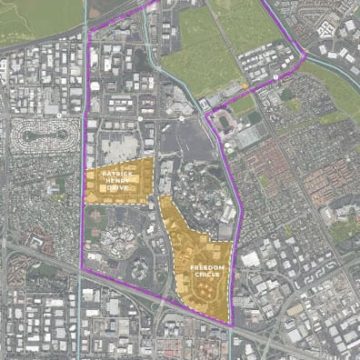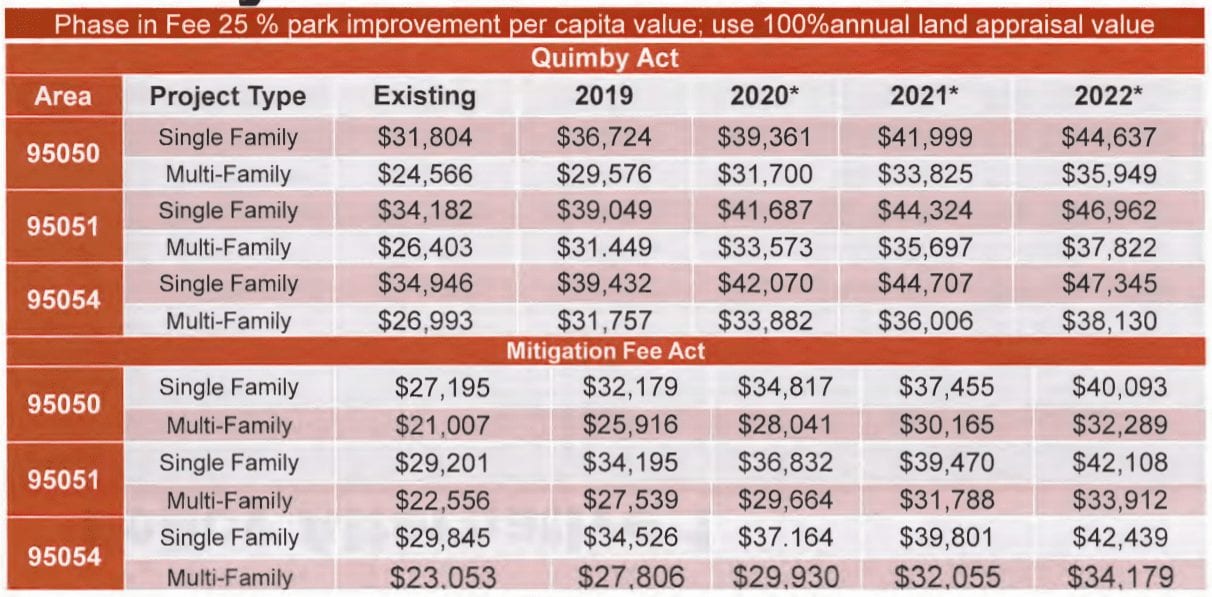Santa Clara councilmembers are grappling with a slew of technical, long-term planning issues, including raising fees for home developers to bridge a park funding gap and the future of the city’s north side.
The council meeting Tuesday evening ended with requests for more information so lawmakers could make informed decisions on hot-button topics, but the more than five-hour discussion offers insight into how city leaders are envisioning development in the city.
What is ‘City North?’
Santa Clara officials have been working on a slew of specific plans for the city’s north side, but now city leaders are considering looking at the area more holistically, essentially creating an umbrella framework plan that would stitch together those neighborhoods and the space around them.

The umbrella plan would be called the City North Specific Plan and it would include planned growth areas in the city outlined in the Tasman East, Freedom Circle and the Patrick Henry specific plans. Great America Theme Park would be part of the mix along with the Mission College area.
It’s also where the city is vetting big development proposals from developers like KT Urban, Greystar and Chinese developer Kylli. Meanwhile, one of the largest projects in Silicon Valley, the more than 9 million-square-foot Related Santa Clara project, is already under construction in the area.
And if it sounds potentially confusing to have a larger specific plan that encompasses the area where smaller specific plans are already in motion, well, that’s because it is pretty nuanced.
Even so, some councilmembers loved the concept, seeing it as a chance to take a broader look at an area slated for major change. But others, including Mayor Lisa Gillmor, questioned whether kickstarting such an effort wouldn’t complicate things or alienate developers that have been working on projects in the area.
“The specific plans are moving forward, … should we not deal with those?” she asked. “What if they’re not in compliance with the City North framework … at the end of the day, when we’ve had all these developers and property owners involved in a specific plan?”
The other concern from councilmembers Tuesday was the lack of details about what would be included in the City North plan versus the other planning documents being prepared for the area. Community Development Director Andrew Crabtree outlined a City North framework that included a collection of mixed-use neighborhoods with an “urban scale” and an emphasis on walking, transit and bicycling and could include a new shuttle system.
And though some lawmakers seemed unsure about the need for the City North plan and the specifics that it would cover, others seemed intrigued by the idea as a way to put the city more in the driver’s seat as proposals for new development come in.
“I think that’s exactly what we need,” Vice Mayor Patricia Mahan said. “It is important for our city staff to be able to coordinate all these specific plans that are coming together and to have some principles and guidelines to make sure they all end up being compatible with one another.”
Councilmembers unanimously approved a study of the area, but asked that more details be brought back to the council so they could provide feedback on the direction of the plan.
Greystar’s plans: “I feel like we’re back three years ago”
And as if the City North discussion wasn’t complex enough, councilmembers also debated the future of the Freedom Circle Specific Plan, a study of future land uses previously funded by three real estate groups interested in potential development in the area: Greystar, Irvine Cos. and The Sobrato Organization.
City officials informed the council Tuesday, however, that Irvine and Sobrato weren’t interested in pursuing the specific plan anymore. Letters sent to the city from the two developers offer few details about why the groups pulled out of the larger rezoning efforts.

But Gillmor had some insight: “One of the reasons it’s fallen apart is that the developers, at least two that I’ve spoken with, did not like the high density that was proposed in the specific plan so they opted out.”
The two developers pulling out, she said was an “unfortunate result of us not being in tune with the market.”
City staff recommended the council nix the Freedom Circle Specific Plan, but designate the area as a “future focus area,” which would basically be a signal to developers that the city is open to growth. Then the city could evaluate a proposal by Greystar at 3905 Freedom Circle as a lone project.
It’s unclear what Greystar will propose on its 16.6-acres of land. The current concept submitted to the city is a mixed-use development, but Crabtree said Greystar is reevaluating its plans and will submit a new project that focuses more on residential uses.
City leaders unanimously voted to follow staff recommendations and nix the Freedom Circle specific plan, but not before expressing some consternation over the turn of events.
“I feel like we’re back three years ago when we first started talking about the Greystar project and we had the discussion of putting residential in that area that’s sort of isolated,” Gillmor said.
Balancing park land vs. housing
As costs rise to acquire park land and build park amenities, the city is facing a shortfall in meeting its needs, according to Jim Teixeira, director of parks and recreation, who spoke Tuesday to councilmembers about options.
Teixeira recommended the council increase park fees on residential developments by somewhere between 35 percent and 52 percent gradually over a period of three years to help bridge the gap, acknowledging there would continue to be a shortfall in the near-term. But councilmembers worried that such an increase — even spread over several years — would create sticker-shock that might dissuade housing developers from building in Santa Clara at a time when nearly every city in Silicon Valley is facing a severe shortage of homes for its workers.
“I want us to ease the phasing a little bit for the developers, especially with the affordable housing component that we have,” Councilmember Debi Davis said. “I don’t want to slow anything down; I need things to be coming out of the ground.”
City leaders agreed to raise fees, but asked staff members to come back next month to talk about lengthening the period of time to raise the fees. They also voted to start a feasibility study that would look at other options for getting more park fees or contributions toward parks.
“We have to look at ways that we can get creative on how those fees are collected,” Gillmor said.

Koreatown debate returns
Longtime Santa Clarans may remember the Koreatown debate in 2006 and 2007, in which some residents lobbied for a stretch of El Camino Real to be renamed Koreatown. But neighborhood backlash was swift, and the idea was shelved, though the name currently shows up when one looks at the area on Google Maps.
Ken Kim, of the Korean-American Chamber of Commerce, asked the city to revive the discussion Tuesday, citing a majority of businesses in the area that are Korean-owned. But most on the council blanched at the idea, concerned about a repeat of the backlash from more than a decade ago.
“Communities have to build bridges between each other and if this causes friction between communities, can we design it a different way?” Councilmember Raj Chahal said. “I would take a different approach… to show our diversity and help celebrate our diversity.”
Vice Mayor Mahan was the lone official who seemed open to revisiting the proposal.
“I think probably circumstances and times have changed since that time, I’m hoping,” she said. “Face it: people call it Koreatown already and I think we are missing a very important cultural aspect to our city.”
Though the council did place the item on a future meeting agenda for discussion, elected leaders made clear that Koreatown was not a likelihood. Instead, they supported exploring other options to celebrate diversity in the city, like creating an international business district.
Contact Janice Bitters at [email protected] or follow @JaniceBitters on Twitter.



Leave a Reply
You must be logged in to post a comment.